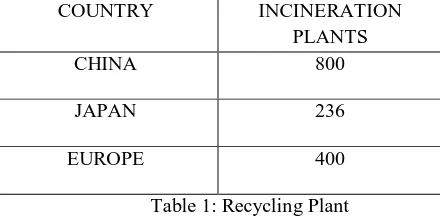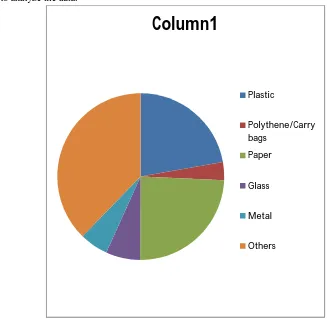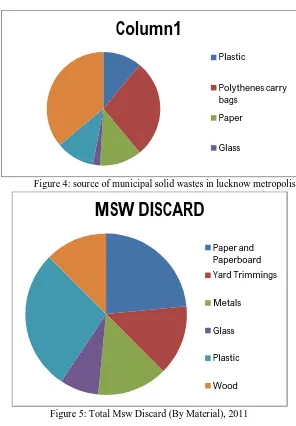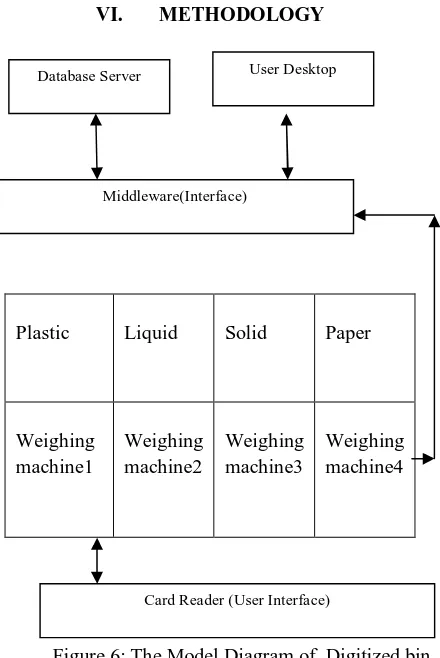Digitization of Waste Management System
Ghanshaym Chaurasia1, Sweeti Sah2, Aman Verma3, Rajesh KumarTiwari (Guide)4
1, 2, 3
M.Tech Student, BBAU, VidyaViharRaibareily Road Lucknow
4
Nodal Officer, Management Info. System Cell, SGPGI, Lucknow
Abstract: This paper presents a proper waste management technique to sustain the environment. The disposals and municipal solid wastes of various states like Delhi, Lucknow, Mumbai, Kolkata and it needs to be managed by certain techniques which can be the next step of Swaach Bharat Abhiyaan. This paper will focus mainly on the characteristics and composition of various heterogeneous wastes (biodegradable and non biodegradable) and environmental issues associated with its management. The primary data can be obtained from structures questionnaires from the random size, population of that area which may lead to higher accumulation of heaps of solid wastes in the Government designated waste dumping sites and open space on the major streets within the metropolis. It can lead to various health and environmental issues. The study strongly recommends that SGPGIMS,Lucknow, Uttar Pradesh, India made to sit up on their unctions while the Government should strongly consider introducing “waste to energy” as a way of curbing the menace of waste management and simultaneously solving the energy needs of the State.
Indexterms: SGPGIMS Lucknow, Environment, Municipal solid waste, Waste management
I. INTRODUCTION
The essential step towards environmentally friendly waste management system is to reduce the current levels of waste generation and increase in material and energy recovery. Landfill is no longer the only way of disposal, there can be various methods of disposing which includes recycling, composting and incineration. Initially incinerators were used globally to reduce waste mass, but nowadays energy is being recovered from incinerators. The recovered bio-gas from landfill produces heat and electricity. From mass view point of material recycling, composting organic waste is considered as the most important system (Marchettini et al., 2007). The problems arising from solid waste can be solved by innovative technologies. Nowadays, different types of waste-to-energy (W-T-E) schemes are available through which energy can be effectively and efficiently recovered as well as used, such as anaerobic digestion (both dry and wet thermophilic and mesophilic) and thermal conversion (rotary kiln incineration, mass burn incineration, starved air incineration, fluidized bed combustion, pyrolysis and gasification, plasma technology, thermo-chemical reduction, refuse derived fuel) and land filling (landfill gas utilization and bioreactor landfill).Each type of technology handle the specific composition and quantity of solid waste (Tatamiuk, 2007). It seems to be difficult to propose appropriate waste management plans and technologies without determining the quantity and composition of generated waste (Idris et al., 2004).
Globally, wastes are used to produce electricity, fertilizer and also used for recycling. Recently the recycling waste of Europe and United States (US) is about 41% and 32% respectively.
COUNTRY INCINERATION
PLANTS
CHINA 800
JAPAN 236
[image:2.612.197.417.531.641.2]EUROPE 400
Table 1: Recycling Plant
The plants in Europe have the capacity to provide electricity of approximately 27 million inhabitants. In India, there are only two methods used for the treatment of solid waste in India, namely the composting (vermin-composting and aerobic composting) and waste-to-energy technologies (pelletization, biomethanation and incineration).
Figure 1: Block Diagram of Waste Management
II. LITERATURE REVIEW
The process of collection, transportation, processing and disposal of waste and residual can be defined in municipal waste management technique. These wastes are generally originated from households, commerce and trade, small businesses, office, building and institution such as hospitals, schools, government building, etc. Apart from landfill there can be various ways of disposing waste such as recycle, composting and incineration. Initially, Incinerators were used globally to reduce waste mass. The landfill bags plays an important role in producing heat and electricity.
The Municipal Waste Management focus on planning, the process of generation of waste and its organization and how to handle these wastes. Each area should have some development strategies that should focus on some specific objectives and measures. Due to rapid industrialization and growing population explosion in India, has led to migration of peoples' villages to cities. Which have generated thousands of tons of Municipal Solid Waste daily.
Consequently the management of Municipal Solid Waste needs to be upgraded to suit the changes in terms of quantity and quality to ensure the longevity of the environment.
Composting the other alternative of recycling, which can be defined as the stabilization process through aerobic decomposition wastes and during composting the nutrients present in the waste are converted into plants available forms Ndegwa and Thompson
(2001) through microbial action3. Among the Municipal Solid Waste Management strategies, composting is gaining interest as an
appropriate option for chemical fertilizers with the help of environmental profit, since this process eliminates or reduces the toxicity of MSW Araujo (2001) Kaushik and Garg (2003) and leads to a final which can be used in improving and maintaining soli quality Lamey and Hao (2007). Application of MSW a final product which can be used in improving and maintaining soil quality Lamey and Hao (2007)4.
III. CURRENT SITUATION OF THE MSW MANAGEMENT SYSTEM IN LUCKNOW CITY
Storage of MSW in Lucknow, residents collect waste in plastic buckets, dustbins and open dump sites. Street sweeping are also collected in community bins. There are 39 bins, 58 dholaons, 303 open dumpsites place across existing 110 wards. There are no separate bins exclusively for the collection of waste paper, plastic, etc.
Waste Reduction
Recycling
Aerobic Composting
Waste-to-energy
Modern landfill recovering and using
CH4
Modern landfill recovering and flaring CH4
Pre-regulation landfill
Figure 2: Types of Waste Collection
IV. MATERIALS AND METHODS
A. Site Description
In this oral interviewis taken from selected residents of major streets in SGPGI Faculty and Employee where these solid wastes are dumped and unattended for very long periods.
B. Sampling Preparation
The evacuation of the waste from the dump sites, composting, disposal methods, the effect on the environment, its management in Lucknow metropolis and also photographed. Some HOD in SGPGIMS was also interviewed, especially on the issues of waste evacuation from the dump sites, legislation, enforcement of existing laws, data analysis and Government support.
C. Analytic methods
MS Excel was used to analyze the data.
Figure 3: Composition of Municipal Solid Waste In Lucknow Metropolis
Column1
Plastic
Polythene/Carry bags
Paper
Glass
Metal
Others Municipal solid waste
Organics Recyclable Inerts
Sand Pebbles Gravels Plastic Paper
Syringes Tablets Tin Can MetalsGlass Kitchen Waste
Figure 4: source of municipal solid wastes in lucknow metropolis
Figure 5: Total Msw Discard (By Material), 2011
V. COMPOSITION OF MUNICIPAL SOLID WASTE IN SGPGIMS
The wastes are composed of biodegradable and non-biodegradable materials. Figure 3 gives a typical picture of the wastes in one of the waste dump sites. With the help of appropriate technology, these biodegradable contents can be converted and processed into another form such as bio-fertilizer or the source of green energy through landfill technology.
Biodegradable matter (43%) and the 57% non-biodegradable, made up of substantially dirt, ash and other household trashs2.
Nabegu (2010) reported that analysis of municipal solid waste in Kano metropolis indicates that they are made up of organic and other
A. Residential Land Encroachment
Land can be used for various purposes and is almost very expensive in urban areas compared to rural areas, hence there is a need of space for residential or other purpose.
B. Recycling
Reusing the discarded material
C. Air Pollution
Airwhich is unfitfor human consumption and can be because of the emission of toxic substances, decay of waste materials, burning or by other factors.
Column1
Plastic
Polythenes carry bags
Paper
Glass
MSW DISCARD
Paper and Paperboard Yard Trimmings
Metals
Glass
Plastic
VI. METHODOLOGY
Plastic Liquid Solid Paper
Weighing machine1
Weighing machine2
Weighing machine3
[image:6.612.201.421.76.405.2]Weighing machine4
Figure 6: The Model Diagram of Digitized bin
This is the proposed solution. Here the wastes, including biodegradable and non biodegradable waste can be dumped into the bins as shown in figure 6. The litter is divided into Plastic, Liquid, Solid, Paper. All these sections of waste have a separate weighing machine which will weigh the amount of litter in it. With the help of middleware the weighing machine will calculate the weight and transfer and feed into the server database daily. This database will be monitored by the user.
The person who wants to dump the litter inside the bin should have a card reader.
VII. DATABASE AND SERVER
It needs a database server that should fetch data and can be accessed to monitor device such as smart card or other device.
The database can be created by SQL Server and with the help of advance technology, creatinga front end for interface between server and user.
VIII. INTERNET FACILITIES
The device can communicate with each other through the internet over a wireless medium.
IX. SKILLED MAN POWER
Require special training of 15 days for users and the manpower requires for recycling waste needs training of 6 months.
X. REQUIREMENT
A. OS :Windows 7 and above.
B. HARDWARE :8 GB RAM, i7 Processor, 2TB SSD, Card Reader Machine.
C. SOFTWARE :
1) Front End :Visual Studio 12 and above.
2) Back End :SQL Server 2008 and above.
Database Server User Desktop
Middleware(Interface)
XI. FUTURE SCOPE
A. Reducing Air Pollution, Air Pollution and Ground Pollution.
B. Reducing Pathogenic diseases.
C. Improving healthy environment (help for Swaach Bharat Mission)
D. Improving Employment and Saving the money.
XII. CONCLUSION
Hence Digitization of Waste Management can be the next step of Swaach Bharat Abhiyaan and Digital India, which can improve the health issues of people and can make eco-friendly environment.It can will also control air pollutionwhich will reduce lung related infection. Through proper training and education there can be an employment opportunity for people.This modern process of collecting the litter and saving the data of litter weight daily in its database can make a proper record of all types of waste so that they can be recycled and reused accordingly. This can be made possible with this proposal.
REFERENCES
[1] International Journal of Scientific & Engineering Research, Volume 4, Issue 11, November-2013 164 -ISSN 2229-5518 IJSER © 2013 http://www.ijser.org:Solid Waste Management and Characteristics inLucknow, Uttar Pradesh, India.
[2] International Journal of Scientific Research in Environmental Sciences, 3(3), pp. 0107-0118, 2015 Available online at http://www.ijsrpub.com/ijsres ISSN: 2322-4983; ©2015; Author(s) retain the copyright of this article http://dx.doi.org/10.12983/ijsres-2015-p0107-0118.
[3] IJMRD 2015; 2(2): 96-99 www.allsubjectjournal.com.Municipal solid waste management with special Reference to Lucknow.
[4] Sunil KG, Sandeep KR, Pandey NB, Singh AS, VivekKS, Trisha V. Municipal Solid Waste CharacterizationAnd Management Strategies for Lucknow City, 2013
[5] http://www.distancesfrom.com/ng/EBONYI-STATE-latitude-longitude-EBONYI-STATE-latitude-EBONYI-STATE- longitude/LatLongHistory/891025.aspx. Accessed October 10, 2014.
[6] http://en.wikipedia.org/wiki/Ebonyi_State. Accessed October 11, 2014. [7] http://www.ebonyionline.com/about-ebonyi-state/ . Accessed October 12, 2014




